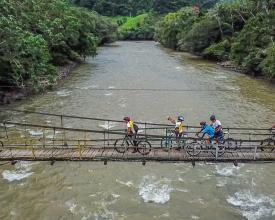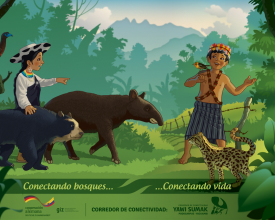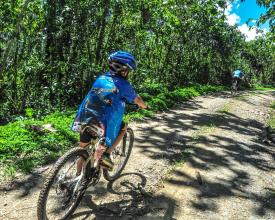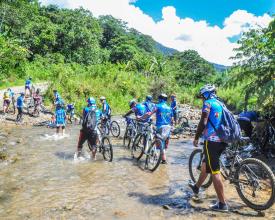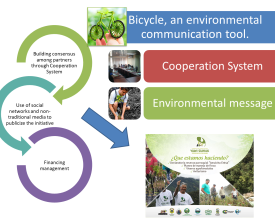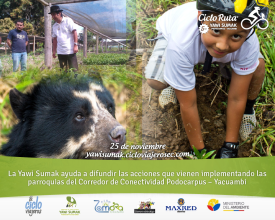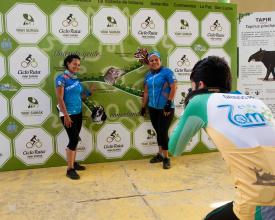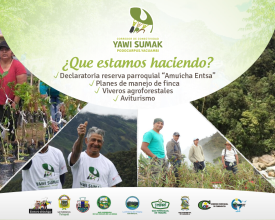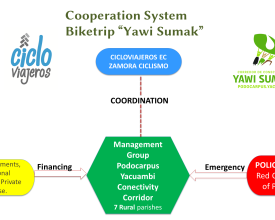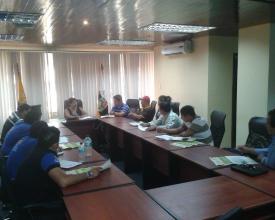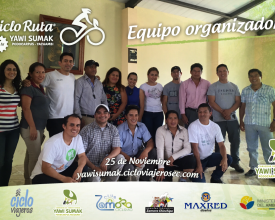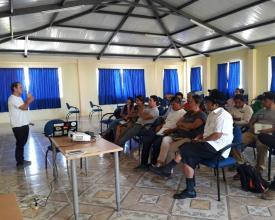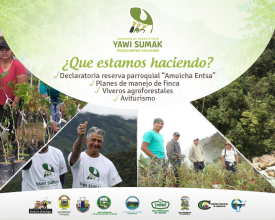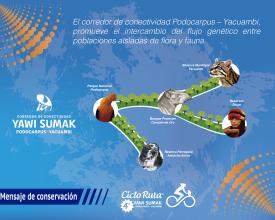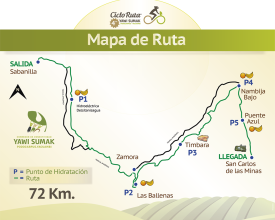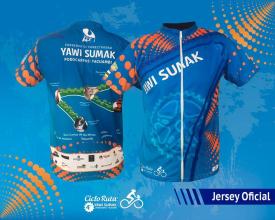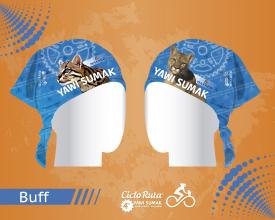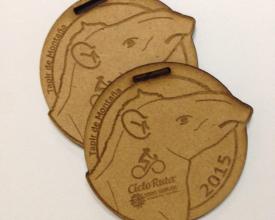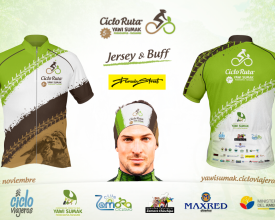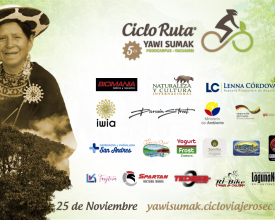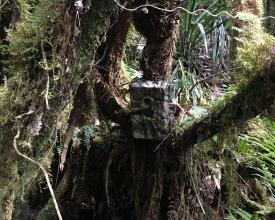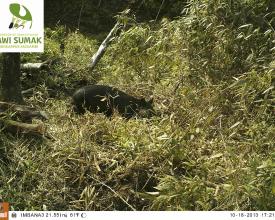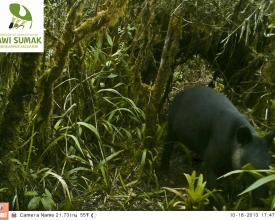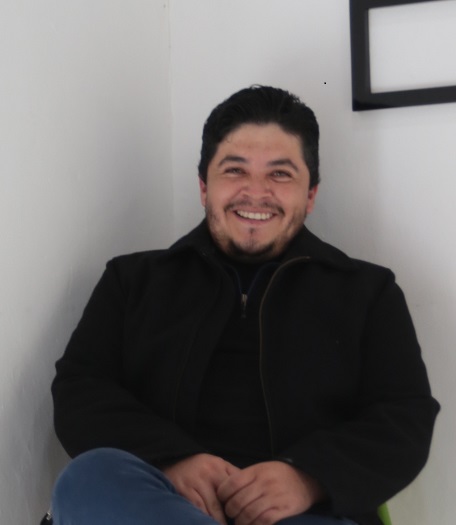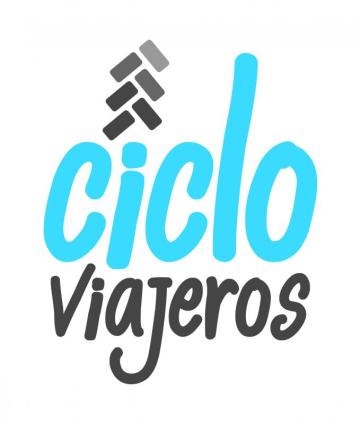
YAWI SUMAK : La bicyclette, un outil de communication environnementale.
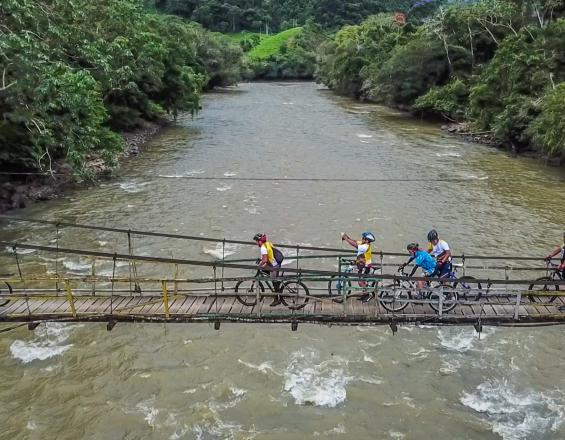
Yawi-Sumak est un mélange de deux mots indigènes : Yawi signifie saladero, un endroit dans la forêt où les oiseaux et d'autres créatures se rassemblent pour consommer des sels minéraux, et Sumak signifie beau ou grand. Les activités entreprises par les autorités environnementales, les médias locaux et la communauté en matière de conservation et d'utilisation durable des ressources naturelles sont illustrées par une randonnée à vélo à laquelle participent plus de 300 cyclistes. Cet outil de communication unique et inclusif offre aux résidents urbains une expérience vécue de la beauté visuelle de la région, des services écologiques, des espèces parapluies et de la diversité culturelle des groupes ethniques Shuar, Saraguro et Mestizo.
Le concept a été repris dans le programme régional AbE Ecuador pour promouvoir l'écotourisme communautaire à Membrillal, Manabi, et est devenu l'excursion à vélo la plus importante du pays. Il a été présenté lors du Forum mondial de la bicyclette 2017 à Mexico.
Contexte
Défis à relever
- Les moyens de communication conventionnels pour les projets de conservation de l'environnement (conférences, congrès, brochures, affiches, etc.) ne sont suivis que par des publics spécialisés dans les questions environnementales, des universitaires et des institutions connexes.
- Nécessité de diffuser les actions des gouvernements locaux pour le maintien et l'utilisation durable des ressources naturelles, telles que : le suivi des espèces, l'apiculture, la reforestation, la gestion des sources d'eau.
- La recherche de stratégies de communication et d'éducation environnementale inclusives et innovantes qui permettent de voir en pratique les espèces (espèces umbrela), les services écosystémiques et la beauté du paysage du corridor de connectivité Podocarpus - Yacuambi (CPY).
- La population urbaine de Loja et de Zamora n'est pas consciente de l'importance des services écosystémiques fournis par le CPY, en particulier de la valeur de l'eau, car dans cette zone, environ 50 % de l'eau est produite pour la ville de Loja.
- Il n'y a pas de budget spécifique pour la communication environnementale dans l'ICP.
Emplacement
Traiter
Résumé du processus
Après l'événement, les participants, les organisateurs, les institutions environnementales et la communauté locale de cette initiative obtiennent un produit de haute qualité avec un fort potentiel de communication.
La gestion et l'organisation de l'événement par le biais du système d'association et de coopération fournissent un message expérimental aux cyclistes (habitants de la ville).
Sans une interaction adéquate entre les parties prenantes, le message, l'élément de communication (vélo) et le budget, il serait impossible de générer une expérience de conservation telle que celle réalisée par l'initiative Yawi Sumak.
La preuve en est que l'initiative a déjà été reproduite dans plusieurs zones de conservation de l'Équateur (Garua Bike Trip, Manabi, Équateur) ou Bi-national Bike-Trip of the Dry Forest Ecuador-Perú.
Nous devons tenir compte du rôle important de la bicyclette en tant qu'outil de communication. Le succès de cette initiative est dû en grande partie à l'autonomisation, à la noblesse et à l'acceptation de ce mode de transport durable chez les participants et aux sentiments de liberté en contact avec la nature, les gens et la communauté.
Blocs de construction
Obtenir un consensus entre les partenaires par le biais de la consultation
Réaliser des réunions de coordination entre les groupes de cyclistes et le groupe promoteur du corridor de connectivité de l'API pour définir le budget, l'itinéraire, la feuille de route, les responsabilités et le message qui sera transmis dans l'édition actuelle, par exemple : groupes ethniques, ours à lunettes - ours des Andes (Tremarctos Ornatus), tapir de montagne (Tapirus pinchaque), ressources en eau, etc.
Dans un second temps, tous les acteurs se réunissent : l'autorité environnementale, l'entreprise privée et les institutions d'aide pour convenir de la logistique, des questions de soutien et du plan d'urgence pour assurer la sécurité des cyclistes.
La structure et la communication dans un espace gouvernemental sont la clé du succès de l'événement, mais il est parfois difficile de gérer certains conflits pour le leadership et le protagonisme institutionnels.
Facteurs favorables
- Disposer d'un système de coopération.
- Établir des canaux de communication adéquats.
- Générer un leadership horizontal, en évitant les intérêts politiques et économiques.
- Être conscient de l'existence d'un objectif commun
Leçon apprise
- Le leadership doit être géré par la société civile.
- La gestion des ressources économiques pour le développement de l'événement doit être assurée par une organisation de la société civile.
- L'interférence d'intérêts politiques dans les décisions ne doit pas être autorisée.
- La participation d'entreprises privées est la clé de la durabilité.
- La planification doit se faire environ trois mois à l'avance.
Utilisation des réseaux sociaux et des médias non traditionnels pour faire connaître l'initiative
La stratégie de communication pour diffuser l'importance et les actions de la CPY doit être inclusive et innovante, à travers la création d'une marque et des messages clés à transmettre chaque année aux cyclistes, les participants devraient facilement identifier l'objectif principal de l'initiative.
En ce sens, nous créons des produits publicitaires tels que : conférence de presse, publicité, infographies, cartes, affiches, maillot, buff, médailles qui sont divulgués lors de la promotion et le développement des événements à travers les plateformes numériques et les réseaux sociaux : site web, facebook, twitter, etc...).
Un autre espace pour diffuser le concept de cyclisme est que pendant le tour il y a des arrêts stratégiques pour l'hydratation, des collations saines et naturelles pour les cyclistes ; Ces espaces sont utilisés par les gouvernements locaux et les communautés pour promouvoir les produits de leur agrobiodiversité et bioemprendimientos.
Pour socialiser le concept de durabilité, lors de la campagne publicitaire sur les réseaux sociaux, il est indiqué que la nourriture sera livrée dans des contenants durables (feuilles de bananier) et que l'hydratation sera livrée dans ses bouteilles réutilisables (les bouteilles en plastique ne doivent pas être utilisées).
Facteurs favorables
Définir un concept clair que nous voulons diffuser parmi les cyclistes.
Maintenir l'engagement des gouvernements locaux à promouvoir les produits de leur agrobiodiversité.
Établir les canaux de communication appropriés pour atteindre le groupe cible.
Utiliser un site web d'inscription pour la conceptualisation de l'événement : yawisumak.cicloviajerosec.com / www.ciclorutadelagarua.com
Faire appel à un graphiste créatif et conscient de l'objectif à transmettre.
Leçon apprise
Le fait d'avoir un concept de voyage à vélo encourage l'intérêt et augmente la participation des cyclistes.
La diffusion des concepts de l'API à l'avance pendant la promotion de l'événement est essentielle pour sensibiliser les cyclistes.
Le site web et les réseaux sociaux sont des plateformes clés pour avoir une portée nationale.
Disposer d'un enregistrement photographique de bonne qualité permet aux participants de s'identifier dans les réseaux sociaux, de taguer et de partager les photos et le message de l'événement une fois l'événement terminé.
Ressources
Gestion du financement
Le cyclotourisme Yawi Sumak, au-delà d'un événement récréatif et sportif, a un objectif de sensibilisation à l'environnement. Il a suscité l'intérêt et le soutien économique des gouvernements locaux (préfecture de Zamora Chinchipe, conseils paroissiaux), de la coopération internationale (coopération allemande GIZ) et d'entreprises privées (Maxred Diseños).
Pour cette raison, le coût est subventionné et symbolique. Le cycliste paie environ 40% de la valeur réelle de l'événement, ce qui a contribué de manière significative au succès de l'appel. Pour ce prix, le participant reçoit : la mobilisation, le transport des vélos, la nourriture (petit-déjeuner, sandwichs froids et déjeuner), le maillot, le buff, la médaille de participation, l'hydratation, les fruits, le tirage au sort, le contrôle du trafic, l'assistance médicale et l'assistance mécanique.
Lors de la dernière édition, il y a eu une différence entre les hommes (20 $) et les femmes (15 $) afin d'encourager une plus grande participation des femmes.
Facteurs favorables
Générer un message environnemental (conservation, connectivité) au-delà d'une activité récréative et sportive pour atteindre l'intérêt de la coopération internationale.
Obtenir une grande participation des cyclistes dès le début, qui augmente progressivement, ce qui a suscité l'intérêt des entreprises privées.
Disposer d'un espace de gouvernance permanent (Cooperatio System - groupe promoteur du CPY) pour la gestion des ressources du gouvernement local.
Leçon apprise
Les entreprises privées sont prêtes à soutenir des idées novatrices, à condition qu'elles recherchent un intérêt commun et qu'elles fassent appel à la participation d'un grand nombre de personnes.
La bicyclette est très bien acceptée (être favorable à la bicyclette est cool), par exemple, par les entités publiques et privées dans les domaines du transport, de l'écologie, des loisirs, de l'accessibilité et de la cohésion sociale.
La gestion des ressources dans les institutions sera plus facile si elles sont orientées vers les questions environnementales, dans ce cas le préfet local est un indigène du groupe ethnique Saraguro, c'est un défenseur de la nature qui en 2009 par le biais d'une loi locale a établi la province de Zamora Chinchipe comme "Poumon de la Terre Mère, Source d'Eau et de Vie".
Ressources
Fonds de conservation
Comme stratégie de connexion et de contribution de la citoyenneté, parce que dans la première édition (2013) nous avons été en mesure de financer toutes les dépenses, un fonds de conservation a été généré à partir de la collecte du coût de l'inscription à l'événement, le fonds a été remis au groupe promoteur CPY et il a été investi dans des actions de conservation et l'utilisation durable du territoire, avec le fonds a été acheté des caméras de piège pour la surveillance de la biodiversité.
Cette proposition n'était pas viable pour les éditions suivantes, en raison de l'augmentation considérable de la participation et des coûts associés, actuellement nous utilisons les frais d'inscription pour compléter le financement de l'événement.
Facteurs favorables
Avoir un projet de conservation emblématique dans la région.
Avoir atteint le financement total de l'initiative au cours de sa première année.
Disposer d'un espace de gouvernance permanent (système de coopération et groupe promoteur de l'API).
Leçon apprise
Il est nécessaire de consacrer davantage d'efforts à la collecte de ressources économiques pour maintenir le fonds de conservation.
L'affectation de l'argent collecté à des projets locaux permet de renforcer la relation entre le groupe promoteur et la communauté.
Le fait d'avoir une institution externe qui aide à financer 100 % de l'événement permet de créer le fonds de conservation.
Ressources
Impacts
La mise en œuvre de cette initiative a permis de générer des impacts positifs dans la région, tels que
- Réactivation de l'économie locale des communautés.
- Diffusion de l'importance et du travail développé dans le corridor de connectivité Podocarpus - Yacuambi.
- Attirer les habitants de la ville pour qu'ils connaissent la réalité environnementale des zones protégées.
- Génération de fonds pour les projets de conservation.
- Rupture des différences entre les autorités et les communautés locales.
- Multiplication de cette initiative dans d'autres provinces de l'Équateur.
- Création d'espaces d'intégration nationale et culturelle pour les cyclistes.
Bénéficiaires
Les communautés réactivent leur économie, en particulier les femmes, par la vente de nourriture et de boissons aux points de ravitaillement (400 environ). Cyclistes sensibilisés à l'importance biologique et aux services écosystémiques fournis par le CPY (environ 1500).
Objectifs de développement durable
Histoire
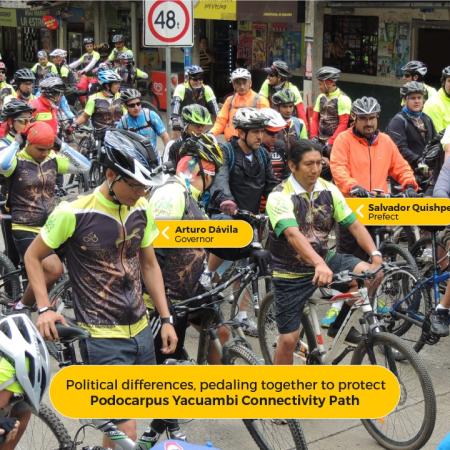
Lors de l'édition 2015, nous avons vécu une histoire politique inhabituelle : Dans cette région, nous avons plusieurs conflits environnementaux en raison de l'expansion de l'industrie minière, il y a deux dirigeants politiques de Zamora, le préfet et le gouverneur de la province, tous deux avaient des divergences politiques, le préfet est un indigène écologiste et le gouverneur est un non-indigène qui représente le gouvernement. Après cette initiative et pour cette cause environnementale, ils ont surmonté leurs divergences politiques et sont parvenus à travailler et à faire du vélo ensemble dans la zone protégée de Podocarpus Yacuambi. Le vélo est vraiment un outil de communication et de synergie politique pour les causes environnementales.

